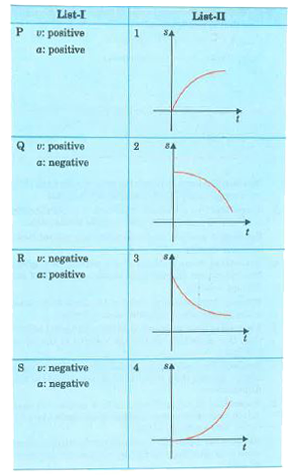Let v and a denote the velocity and acceleration respectively of a body.
a can be nonzero when v = 0
a must be zero when v = 0
a may be zero when v≠0
The direction of a must have some correlation with the direction of v.
The correct Answer is:A, C
Step by step video, text & image solution for Let v and a denote the velocity and acceleration respectively of a body. by Physics experts to help you in doubts & scoring excellent marks in Class 12 exams.
Updated on:21/07/2023Topper's Solved these Questions
- KINEMATICS, FORCESBOOK - D MUKHERJEECHAPTER - KINEMATICS, FORCESEXERCISE - Revision Exercise
26 Videos
- KINEMATICS, FORCESBOOK - D MUKHERJEECHAPTER - KINEMATICS, FORCESEXERCISE - Revision Exercise
26 Videos
- IIT QUESTIONS 5BOOK - D MUKHERJEECHAPTER - IIT QUESTIONS 5EXERCISE - Matrix matching type
2 Videos
- MISCELLANEOUS QUESTION 1BOOK - D MUKHERJEECHAPTER - MISCELLANEOUS QUESTION 1EXERCISE - Miscellaneous Questions-1 (Straight-Objective Type)
54 Videos
Similar Questions
Knowledge Check
Let →v and →a denote the velocity and acceleration respectively of a body in one-dimensional motion.
A|→v| must decrease when →a<0BSpeed must increase when →a>0CSpeed will increase when both →v and →a are <0DSpeed will decrease when →v<0 and →a>0Let v and a represent instantaneous velocity and acceleration of a particle respectively.
AAcceleration a can be zero when velocity v =cancel0BAcceleration a can be nonzero when velocity v=0CAcceleration a can be zero when velocity v=0DAcceleration a must be zero when velocity v=0.Let v and a be the instantaneous velocity and acceleration of a particle moving in a plane. Then rate of change of speed dvdt of the particle is equal to
A|a|Bv.avCthe component of a parallel to vDthe component of a perpendicular to v
If x,v and a denote the displacement, the velocity and the acceleration of a particle executing simple harmonic motion of time period T, then, which of the following does not change with time ?
View SolutionIf x,v and a denote the displacement, the velocity and the acceleration of a particle executing simple harmonic motion of time period T, then, which of the following does not change with time ?
View SolutionIn negative acceleration, the velocity of a body____
View SolutionFor a particle moving in a straight line assume s,v,a and t represents displacement, velocity, acceleration and time respectively.

View SolutionAssertion: A body having non zero acceleration can have a constant velocity.
Reason: Acceleration is the rate of change of velocity.
View Solution
